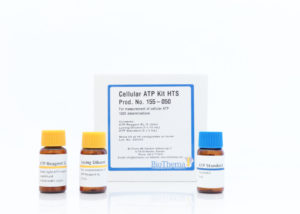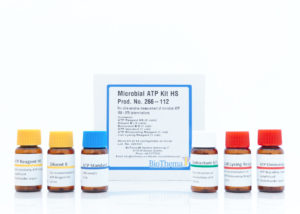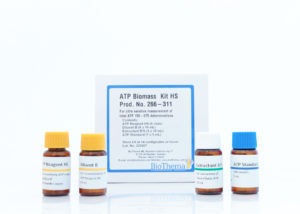Methodology:
All living cells contain ATP and when the cell dies ATP is degraded by intracellular enzymes to ADP and finally AMP. The intracellular ATP concentration is similar in different cell types. This means that bacterial cells contain 1-2 attomoles per cell while animal and plant cells contain 100 to 10 000 times as much ATP. Extracellular ATP may be degraded by adding ATP consuming enzymes or by physical separation. Determination of intracellular ATP can then be used to estimate biomass. If the amount of ATP per cell is known the cell number may also be estimated. In sample which like urine may contain, extracellular ATP, ATP in somatic cells and ATP in bacterial cells all three ATP pools can be determined. Determination of bacterial ATP in urine is used to determine bacteriuria in the diagnosis of urinary tract infection. All ATP assays shall be calibrated by measuring the light before and after adding a known amount of ATP standard at the end of each test. This calibration obviates analytical interference from all sorts of variation of reagents and sample matrices and provides a result expressed in moles rather relative light units.
Intended use:
- Determination of bacterial ATP in urine in the diagnosis of urinary tract infection (UTI)1, 25, 35, 46, 47, 54.
- Antibiotic susceptibility testing5
- Antibiotic concentration determination
- Determination of somatic cells in cow milk (mastitis testing)
- Tumor chemosensitivity testing59
- Cell proliferation and cytotoxicity31, 36
Suitable products for bacteria: ATP Biomass Kit HS, Intracellular ATP Kit HS and Microbial ATP Kit HS
Suitable products for other cells: Cellular ATP Kit HTS, Cell Viability Kit SL
Recommended papers:
Thore A, Nilsson L, Hojer H, Ansehn S, Brote L. Effect of ampicillin on intracellular levels of adenosine triphosphate in bacterial cultures related to antibiotic susceptibility. Acta Pathol Microbiol Scand Sect B. 1977;85: 161–166.
Nilsson L (1978) New rapid bioassay of gentamicin based on luciferase assay of extracellular ATP in bacterial cultures. Antimicrob Agents Chemother 14:812–816
Nilsson L E, Hoffner S E, Ansehn S. Rapid susceptibility testing of Mycobacterium tuberculosis by bioluminescence assay of mycobacterial ATP. Antimicrob Agents Chemother. 1988;32:1208–1212.
Lundin, A., Hasenson, M., Persson, J. and Pousette, Å. (1986) Estimation of biomass in growing cell lines by adenosine triphosphate assay. Methods in Enzymology 133, 27-42.
Hasenson, M., Hartley-Asp, B., Kihlfors, C., Lundin, A. Gustafsson, J. -Å. and Pousette, Å. (1985) Effects of hormones on growth and ATP content of a human prostatic carcinoma cell line, LNCaP-r. The Prostate 7, 183-194.





